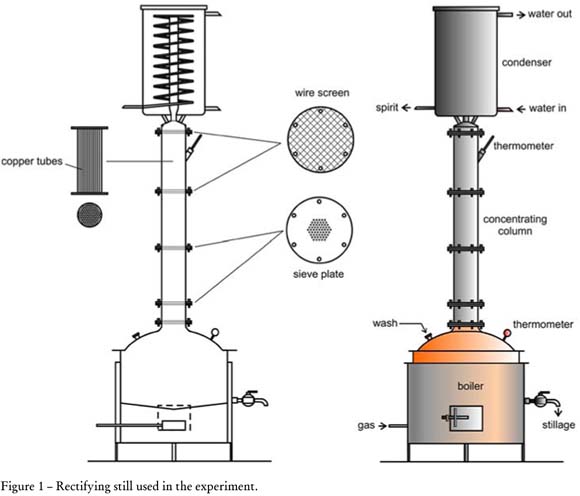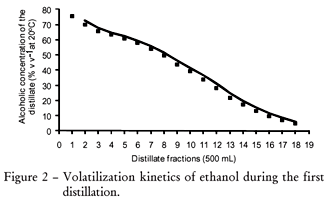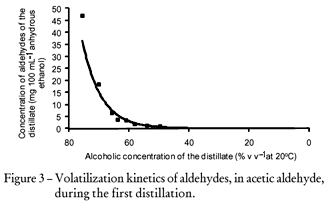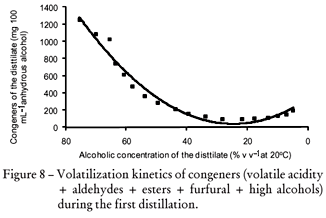Abstracts
The qualitative variation of secondary components plays a key role in the aroma and taste of the sugarcane spirit. The objective of this work was to study the volatilization kinetics of secondary components of sugarcane spirits during double distillation process in a rectifying still to verify the cutoff point in ethanol between "head" and "tail" fractions. Fermented sugarcane juice was distilled in rectifying still according to the methodology used for whisky production. Both distillates from first and second distillations were collected in fractions of 500 mL and analyzed for the concentrations of ethanol, copper, volatile acidity, furfural and hydroxymethylfurfural, aldehydes, esters, methanol and higher alcohols. In the first distillation, aldehydes and esters were distilled at the beginning of the distillation, while acetic acid was distilled at the end of the distillation. Methanol was found in the fractions up to almost half of the first distillation. Higher alcohols were distilled during the whole first distillation, but with greater intensity up to the alcoholic degree of 40% v v-1 of the distillate. During the second distillation, aldehydes, esters and methanol were distilled in the first distillate fractions, being collected mainly at alcohol concentrations above 80% v v-1. Acetic acid was distilled in the final distillate fractions, with concentrations in alcohol content below 20% v v-1. Higher alcohols followed a distillation kinetics pattern similar to ethanol, being collected mainly at alcoholic concentrations above 60% v v-1 of the distillate. The presence of copper, furfural and hydroxymethylfurfural was not detected in any fraction of the distillates of the first and second distillation.
wine; volatile compounds; cachaça
A variação qualitativa dos componentes secundários é função chave no aroma e sabor da aguardente de cana-de-açúcar. Avaliou-se a cinética de volatilização de componentes secundários da aguardente de cana-de-açúcar ao longo do processo de dupla destilação em alambique retificador para verificar tempo de corte em etanol entre a fração cabeça e calda. Mosto fermentado de caldo de cana-de-açúcar foi destilado em alambique retificador seguindo a metodologia utilizada para a produção de whisky. Os destilados, tanto da primeira como da segunda destilação, foram recolhidos em frações de 500 mL e analisados quimicamente quanto às concentrações de etanol, cobre, acidez volátil, furfural e hidroximetilfurfural, aldeídos, ésteres, metanol e álcoois superiores. Na primeira destilação, os aldeídos e os ésteres foram arrastados no início da destilação, enquanto que o ácido acético se destilou no final da destilação. O destilado apresentou concentração de metanol até praticamente metade da primeira destilação. Os álcoois superiores se destilaram durante toda a primeira destilação, porém com maior concentração até a graduação alcoólica de 40% v v-1 no destilado. Durante a segunda destilação os aldeídos, os ésteres e o metanol se destilaram nas primeiras frações do destilado, sendo recolhidos principalmente em concentrações alcoólicas acima de 80% v v-1. O ácido acético se destilou nas frações finais do destilado, tendo se concentrado em teores alcoólicos abaixo de 20% v v-1. Os álcoois superiores apresentaram a cinética de destilação semelhante à do etanol, sendo recolhidos principalmente em concentrações alcoólicas superiores a 60% v v-1 do destilado. Não foi detectada presença de cobre, de furfural e hidroximetilfurfural nos destilados da primeira e da segunda destilação.
vinho; compostos voláteis; cachaça
FOOD SCIENCE AND TECHNOLOGY
Volatilization kinetics of secondary compounds from sugarcane spirits during double distillation in rectifying still
Cinética de volatilização de componentes secundários da aguardente de cana-de-açúcar durante dupla destilação em alambique retificador
André Ricardo AlcardeI,* * Corresponding author < aralcard@esalq.usp.br> ; Paula Araújo de SouzaII; André Eduardo de Souza BellucoI
IUSP/ESALQ Depto. de Agroindústria, Alimentos e Nutrição, C.P. 09 13418-900 Piracicaba, SP Brasil
IIUSP/ESALQ Programa de Pós-Graduação em Ciência e Tecnologia de Alimentos
ABSTRACT
The qualitative variation of secondary components plays a key role in the aroma and taste of the sugarcane spirit. The objective of this work was to study the volatilization kinetics of secondary components of sugarcane spirits during double distillation process in a rectifying still to verify the cutoff point in ethanol between "head" and "tail" fractions. Fermented sugarcane juice was distilled in rectifying still according to the methodology used for whisky production. Both distillates from first and second distillations were collected in fractions of 500 mL and analyzed for the concentrations of ethanol, copper, volatile acidity, furfural and hydroxymethylfurfural, aldehydes, esters, methanol and higher alcohols. In the first distillation, aldehydes and esters were distilled at the beginning of the distillation, while acetic acid was distilled at the end of the distillation. Methanol was found in the fractions up to almost half of the first distillation. Higher alcohols were distilled during the whole first distillation, but with greater intensity up to the alcoholic degree of 40% v v-1 of the distillate. During the second distillation, aldehydes, esters and methanol were distilled in the first distillate fractions, being collected mainly at alcohol concentrations above 80% v v-1. Acetic acid was distilled in the final distillate fractions, with concentrations in alcohol content below 20% v v-1. Higher alcohols followed a distillation kinetics pattern similar to ethanol, being collected mainly at alcoholic concentrations above 60% v v-1 of the distillate. The presence of copper, furfural and hydroxymethylfurfural was not detected in any fraction of the distillates of the first and second distillation.
Key words: wine, volatile compounds, cachaça
RESUMO
A variação qualitativa dos componentes secundários é função chave no aroma e sabor da aguardente de cana-de-açúcar. Avaliou-se a cinética de volatilização de componentes secundários da aguardente de cana-de-açúcar ao longo do processo de dupla destilação em alambique retificador para verificar tempo de corte em etanol entre a fração cabeça e calda. Mosto fermentado de caldo de cana-de-açúcar foi destilado em alambique retificador seguindo a metodologia utilizada para a produção de whisky. Os destilados, tanto da primeira como da segunda destilação, foram recolhidos em frações de 500 mL e analisados quimicamente quanto às concentrações de etanol, cobre, acidez volátil, furfural e hidroximetilfurfural, aldeídos, ésteres, metanol e álcoois superiores. Na primeira destilação, os aldeídos e os ésteres foram arrastados no início da destilação, enquanto que o ácido acético se destilou no final da destilação. O destilado apresentou concentração de metanol até praticamente metade da primeira destilação. Os álcoois superiores se destilaram durante toda a primeira destilação, porém com maior concentração até a graduação alcoólica de 40% v v-1 no destilado. Durante a segunda destilação os aldeídos, os ésteres e o metanol se destilaram nas primeiras frações do destilado, sendo recolhidos principalmente em concentrações alcoólicas acima de 80% v v-1. O ácido acético se destilou nas frações finais do destilado, tendo se concentrado em teores alcoólicos abaixo de 20% v v-1. Os álcoois superiores apresentaram a cinética de destilação semelhante à do etanol, sendo recolhidos principalmente em concentrações alcoólicas superiores a 60% v v-1 do destilado. Não foi detectada presença de cobre, de furfural e hidroximetilfurfural nos destilados da primeira e da segunda destilação.
Palavras-chave: vinho, compostos voláteis, cachaça
Introduction
Sugarcane spirit is a drink with alcoholic degree ranging from 38 to 54% v v-1 at 20°C obtained through the distillation of fermented sugarcane juice (Brasil, 2005a). Besides alcohol and water the spirit is also composed of several volatile secondary components. These secondary compounds influence, alone or combined, the the functional classes of acids, esters, aldehydes and alcohols (Maia, 1994).
The most abundant class of these compounds is composed of higher alcohols, produced along with ethanol during fermentation. Organic acids may contribute directly to the aroma or indirectly for being involved in the formation of esters. Carbonyl compounds such as acetaldehyde, diacetyl, furfural and acrolein are present in small concentrations, but due to their very low sensory perception limit, also influence the taste of the drink. Esters are compounds formed through the reaction of alcohols and acids. Methanol, a contaminant of the sugarcane spirit, is originated from the degradation of pectin (Maia, 1994).
Volatile components from wine have different volatility degrees, which enables their separation through distillation. For sugarcane spirits, there is no report in the literature on the volatilization sequence of chemical compounds along distillation. The literature regarding the distillation process for the cognac and whisky production (Léauté, 1990; Yokoya, 1995; Piggott and Conner, 2003) classifies secondary volatile compounds from wine/wash into three groups: i) Group 1: components that distill first, or have low boiling point and are soluble in alcohol. Most are separated at the beginning of the distillation and their concentrations are relatively higher in the first distillate fractions. Acetaldehyde (BP = 21ºC) and ethyl acetate (BP = 77ºC) are included in this group, also known as "head" distillate fraction; ii) Group 2: components that have boiling point below 200°C, are soluble in alcohol and completely or partially soluble in water. Methanol (BP = 64.6ºC) and higher alcohols propanol, isobutanol and isoamyl belong to this group; and iii) Group 3: components that have boiling point higher than water. Acetic acid (BP = 118ºC), soluble in water, and furfural (BP = 162ºC), only slightly soluble in water, are part of this group, also known as "tail" distillate fraction.
Distillation of the sugarcane derived fermented must or "wine" in copper pot stills or stainless steel columns and the fermentation are the most important steps in the production of the spirit, called "cachaça" in Brazil. The products are dependent on the type of distillation apparatus, the material employed in their construction, and the intensity and homogeneity of the heat source. The copper pot still process corresponds to one plate; a column is a continuous process involving many plates. The levels of ethanol and head fraction in the pot still are smaller than those in the columns.
The objective of this research was to study and monitor the volatilization kinetics of secondary components (volatile acidity, aldehydes, esters, higher alcohols, furfural, hydroxymethylfurfural, copper and methanol) and the concentration of ethanol from sugarcane spirits during double distillation processes in rectifying stills.
Material and Methods
Whole sugarcane stalks of the variety SP80-3280 were milled to extract the juice which was filtered through cotton, boiled for 10 min, cooled, filtered again and diluted to 18°Brix. The juice was inoculated with Saccharomyces cerevisiae yeasts (strain Y-904) in the form of dried live yeast.
Fermentation was conducted in stainless-steel tanks with 13 L of useful capacity. The fermentation temperature was controlled between 28 and 30°C by a thermostatic bath. The fermentations started with 3 g of dry yeast per liter of juice. The yeast was recycled for 2 further fermentative cycles by decantation. The fermented sugarcane juice (wash) was distilled in a rectifying still with a gas heating system, copper boiler with 37 liters of useful capacity, stainless steel rectifying column with 4 plates and stainless steel condenser (Figure 1).
The distillation technique consisted of double distillation, based on the methodology used for whisky production (Piggott and Conner 2003). The first distillation virtually extracted all the alcohol from the wash, that is, until the distillate in the condenser outlet presented approximately 5%v v-1 measured in an alcoholmeter. The distillate from the first distillation was collected in fractions of 500 mL and a sample of 50 mL was taken of each fraction for chemical analysis. Thus, it was possible to study and monitor the behavior of volatile secondary compounds (aldehydes, esters, methanol, ethanol, higher alcohols and organic acids) during the first distillation. The distillate of the first distillation, called "low wines" was submitted to a second distillation. Three batches of first distillations were required to produce enough volume of low wines for the second distillation. In the second distillation, the "low wines" were distilled and also collected in fractions of 500 mL. Samples of 50 mL were collected from each fraction for chemical analysis. In this case, the preferential distillation sequence of the secondary volatile compounds was studied along the second distillation.
The distillate fractions from the first and second distillation were analyzed for the concentration of ethanol, volatile acidity, furfural, hydroxymethylfurfural and copper, according to official methodologies described in Brasil (2005b).
The analyses of esters, aldehydes, higher alcohols and methanol were performed using a GC-037 gas chromatograph equipped with a PAAC 3334-GC packed column and a flame-ionization detector (FID). H2 was used as carrier gas, with a flow rate of 30 mL min1. The injector temperature was adjusted to 170°C. The column temperature programming was isothermic at 94°C. The detector temperature was adjusted to 225°C (Miranda et al., 2008).
Results and Discussion
During the first distillation, the ethanol concentration in the distillate decreased linearly over the course of distillation (Figure 2). In an overall sense, the secondary compounds behaved as reported by Léauté (1990); Yokoya (1995) and Piggott and Conner (2003), i.e., they vaporized according to their volatility (Table 1). The most volatile compounds were distilled at the beginning of the distillation, such as aldehydes (Figure 3) and esters (Figure 4), while the less volatile were distilled at the end of the distillation, such as acetic acid (Figure 5). Although the pure acetic acid has a boiling point at 117°C, it becomes volatile due to its high activity coefficient in dilute aqueous solutions, as cited by Maia (1994).
Methanol was found in the fractions up to almost half of the first distillation (Figure 6). At the end of the distillation, the methanol concentration in the distillate, which was expressed in mg 100 mL-1 anhydrous alcohol, tended to increase due to the presence of ethanol in the final distillate fractions. Higher alcohols were distilled during the entire distillation (Figure 7); however, with greater intensity up to the alcoholic degree of 40% v v-1 in the distillate. The volatilization kinetics of congeners (Figure 8) represents the interaction of volatilization kinetics of esters, aldehydes, organic acid and higher alcohols. Probably due to the higher alcoholic concentration of low wines (39.84% v v-1) in relation to wine (10.17% v v-1), the second distillation intensified the volatility tendency of secondary compounds (Table 2).
The ethanol concentration in the distillate decreased over the course of the second distillation, but it remained above 60% v v-1 for almost 3/4 of the distillation time, decreasing only at the end of the distillation (Figure 9). Aldehydes (Figure 10), esters (Figure 11) and methanol (Figure 12) were distilled in the first distillate fractions, having been collected in alcoholic concentrations above 80% v v-1, i.e., in the "head" distillate fractions. The acetic acid was distilled in the final distillate fractions (Figure 13), with concentrations in alcohol content below 20% v v-1, i.e., in the "tail" distillate fractions.
The higher alcohols, despite having higher boiling points in relation to ethanol, followed a distillation kinetics trend similar to ethanol, being collected mainly at alcoholic concentrations above 60% v v-1 (Figure 14). Higher alcohols, belonging to the class of alcohols such as ethanol, have affinity with ethanol and distillate together, probably by forming azeotropic mixtures with each other. These results differed from those of Guymon (1972), who reported that higher alcohols tend to be distilled from half of the distillation on.
As in the first distillation, the volatilization kinetics of congeners (Figure 15) represents the interaction of the volatilization kinetics of esters, aldehydes, organic acids and higher alcohols during the second distillation. The presence of copper, furfural and hydroxymethylfurfural was not detected in distillates from both first and second distillation. When the second distillation is performed, part of the water in the wine had already been removed in the first distillation, concentrating the low wines in ethanol and also in secondary volatile compounds. Therefore, the purpose of the second distillation is to remove contaminants and to reduce the concentrations of secondary compounds in order to improve the quality of the distillate and make it suitable to the legislation in force, as cited by Bizelli et al. (2000).
For the production of sugarcane spirits to meet the legislation and taking into account the results obtained in this work, one could propose limiting the "heart" distillate fraction between 83 and 30% v v-1 of ethanol, therefore corresponding to distillate fractions 3 to 26 from the second distillation (Table 2). Thus, by calculation using data in Table 2, the spirits would have alcoholic concentration of 72.21% v v-1, aldehydes concentration of 11.36 mg 100 mL-1 of anhydrous alcohol, esters concentration of 10.45 mg 100 mL-1 of anhydrous alcohol, methanol concentration of 6.57 mg 100 mL-1 of anhydrous alcohol, volatile acidity of 12.62 mg 100 mL-1 of anhydrous alcohol, higher alcohols concentration of 347.95 mg 100 mL-1 of anhydrous alcohol and coefficient of congeners of 382.38 mg 100 mL-1 of anhydrous alcohol.
The alcoholic concentration of these spirits would be above the maximum level allowed by the Brazilian legislation (38 to 54% v v-1); however, this would not be a problem since it could be diluted with potable water up to an alcoholic concentration within the limits established by law. Prado-Ramírez et al. (2005) also reported that monitoring ethanol content is a critical factor in determining how the slop cuts and distilled product meet the tequila norm regardless of the type of the used pot still (stainless still or copper). Regarding the other chemical compounds, these spirits would meet the identity and quality standards established by Normative Instruction No 13, June 30, 2005 (Brasil, 2005a). However, a sensory evaluation of the spirits would be important to verify whether the cutoff point in 30% ethanol v v-1 between "heart" and "tail" fractions would not introduce some undesirable components to the drink, which could negatively interfere in its sensory quality. The double distillation methodologies employed in the whisky and cognac production establish that the cutoff point between "heart" and "tail" fraction during the second distillation must be conducted when the distillate in the condenser outlet presents 60% of alcohol v v-1 (Léauté, 1990; Piggott and Conner, 2003).
Conclusion
The study and monitoring of the volatilization kinetics of secondary components, concentration of ethanol from sugarcane spirits during double distillation process in rectifying still and sensory evaluation of the spirits was very important to verify when the cutoff point in ethanol between "head" and "tail" fractions should be taken.
Acknowledgements
The authors are grateful for the support provided by FAPESP.
Received May 08, 2009
Accepted February 25, 2010
- Bizelli, L.C.; Ribeiro, C.A.F.; Novaes, F.V. 2000. Double distillation of sugar cane spirit: copper and total acidity contents. Scientia Agricola 57: 623-627 (in Portuguese, with abstract English).
- Brasil. Laws, decrees. Normative Instruction n. 13 of 29 Jun. 2005. Diário Oficial da União. Brasília, jun. 30, 2005a (in Portuguese).
- Brasil. Laws, decrees. Normative Instruction n. 24 of 8 de Sept. 2005. Diário Oficial da União. Brasília, sep. 9, 2005b.
- Guymon, J.F. 1972. Higher alcohols in beverage brandy. Feasibility of control of levels. Wines and Vines 53: 37-40.
- Léauté, R. 1990. Distillation in alambic. American Journal of Enology and Viticulture 41: 90-103.
- Maia, A.B.R. 1994. Secondary compounds of cane sugar spirits. STAB, Açúcar Álcool e Subprodutos 12: 29-34 (in Portuguese, with abstract in English).
- Miranda, M.B.; Martins, N.G.S.; Belluco, A.E.S.; Horii, J.; Alcarde, A.R. 2008. Chemical profile of aguardente: Brazilian sugar cane alcoholic drink; aged in oak casks. Ciência e Tecnologia de Alimentos 28: 84-89 (in Portuguese, with abstract in English).
- Piggott, J.R.; Conner, J.M. 2003. Whiskies. p. 239-262. In: Lea, A.G.H.; Piggott, J.R., eds. Fermented beverage production. Klumer Academic, New York, NY, USA.
- Prado-Ramírez, R.; Gonzáles-Alvarez, V.; Pelayo-Ortiz, C.; Casillas, N.; Estarrón, M.; Gómez-Hernández, H. 2005. The role of distillation on the quality of tequila. International Journal of Food Science and Technology 40: 701.
- Yokoya, F. 1995. Production of Sugar Cane Spirit. Fundação Tropical de Pesquisas e Tecnologia André Tosello, Campinas, SP, Brazil.
Publication Dates
-
Publication in this collection
14 June 2010 -
Date of issue
2010
History
-
Received
08 May 2009 -
Accepted
25 Feb 2010


















